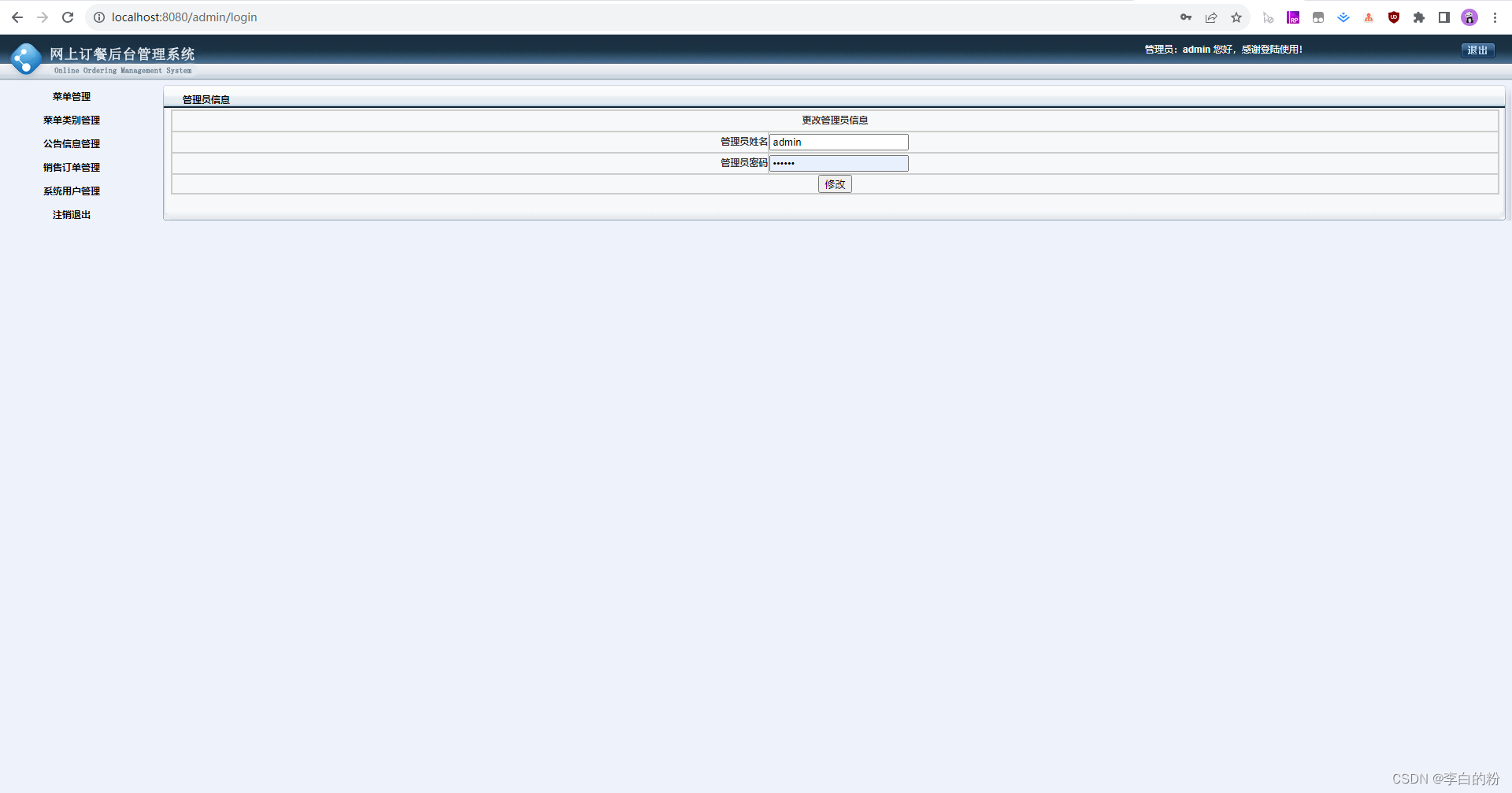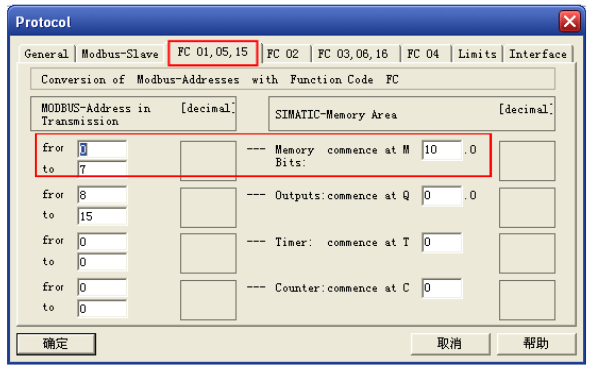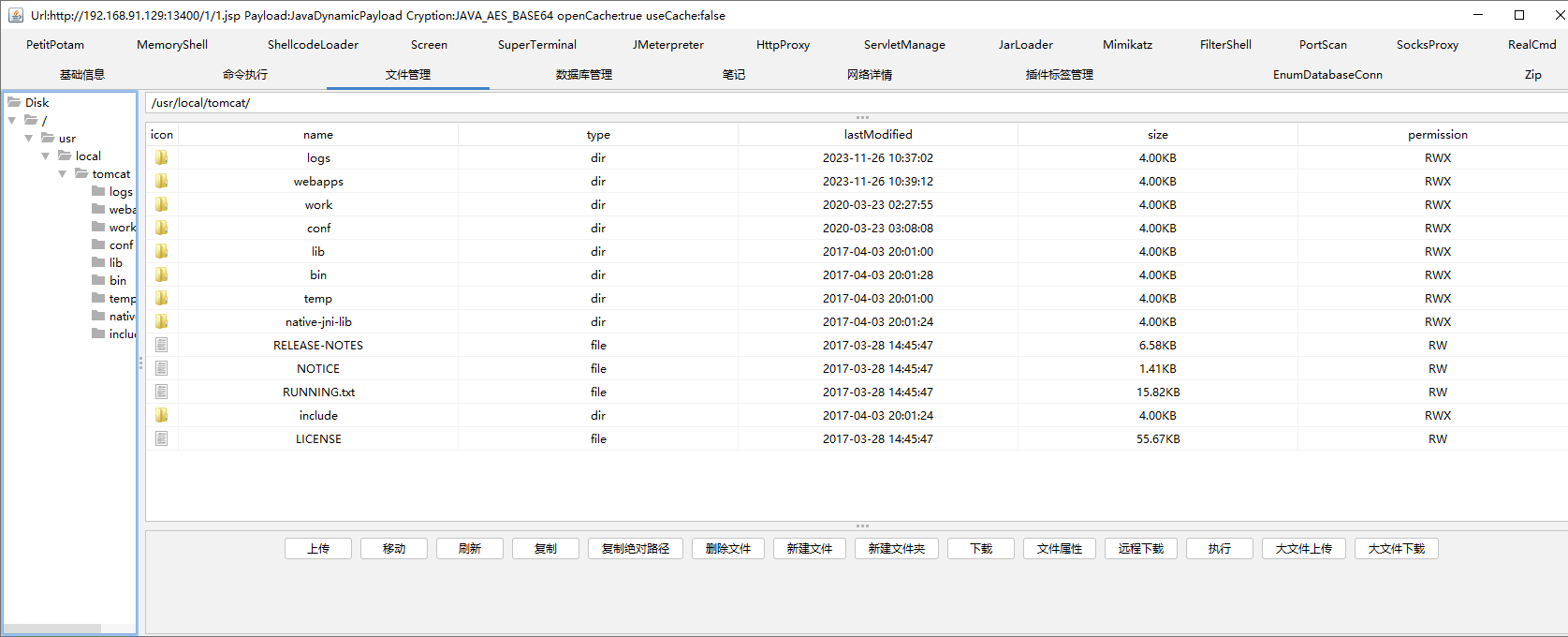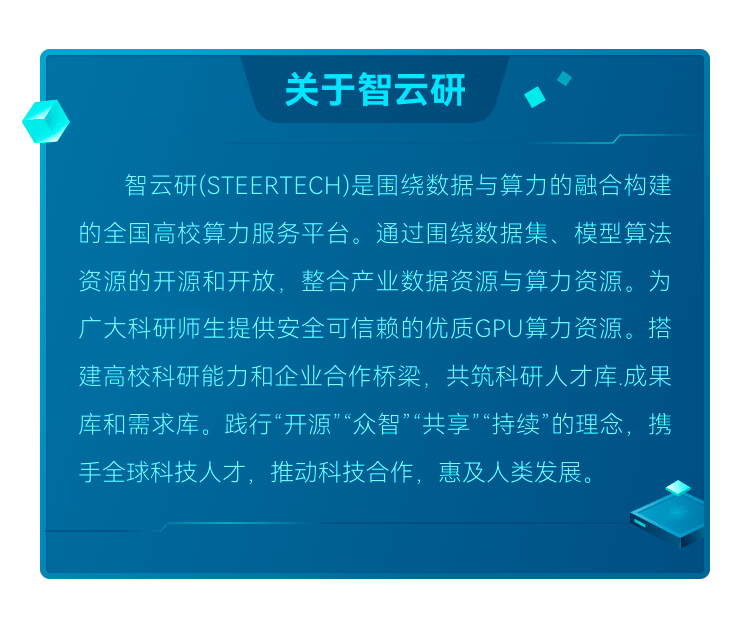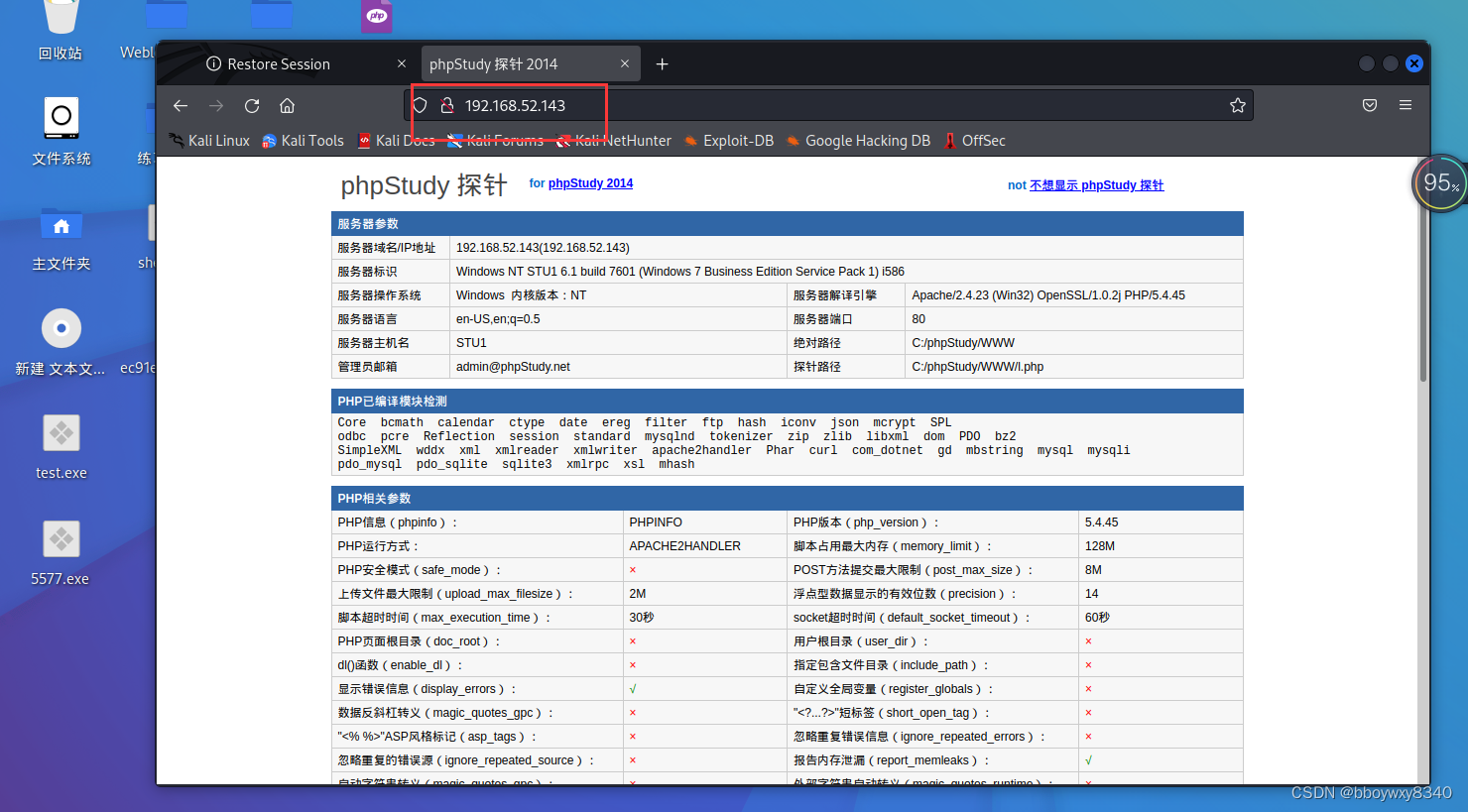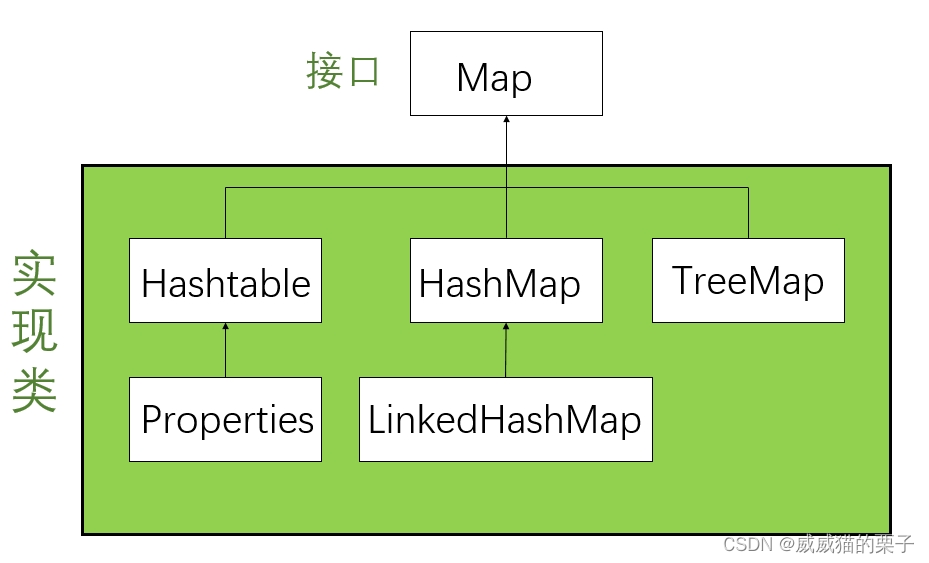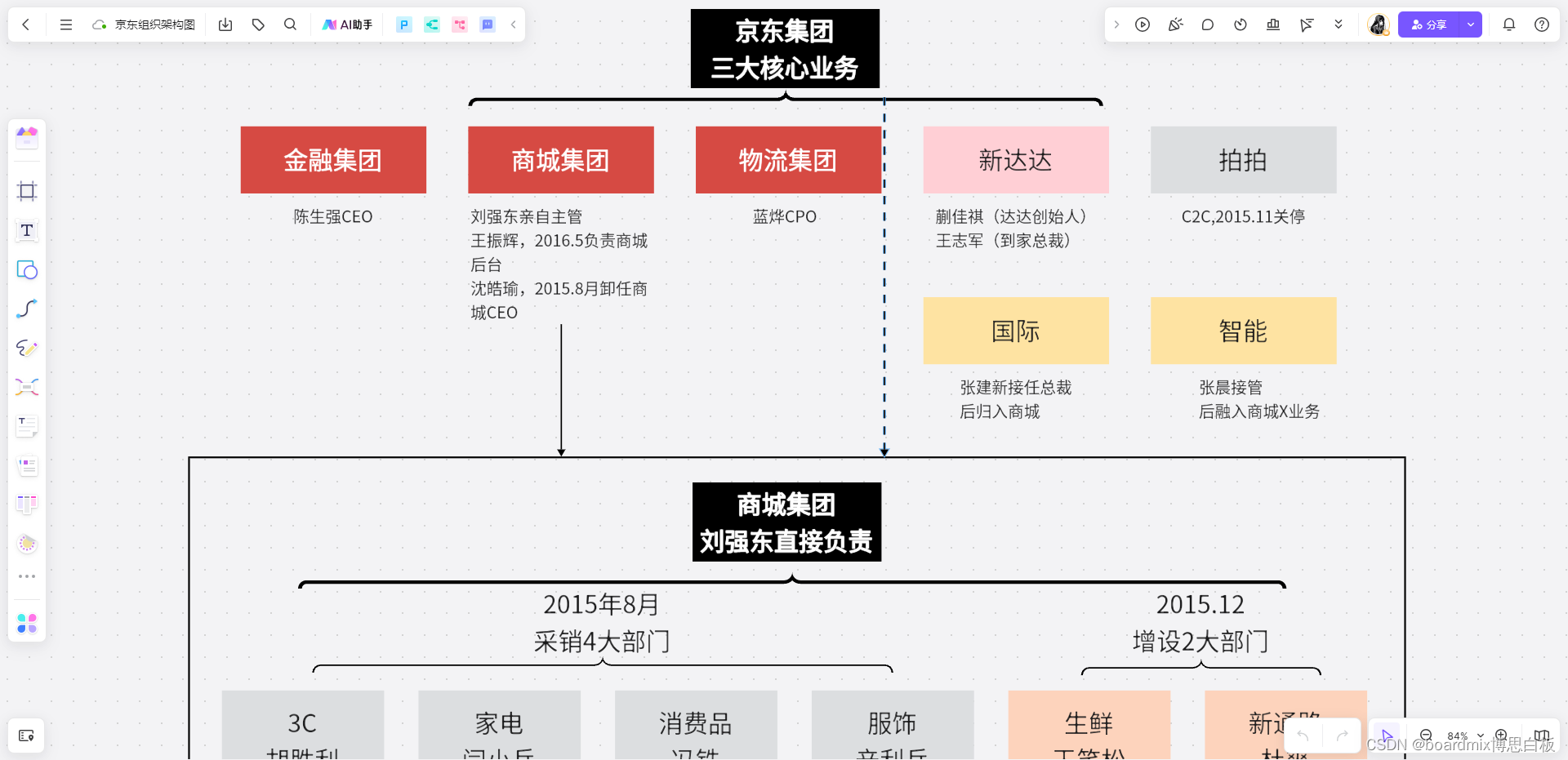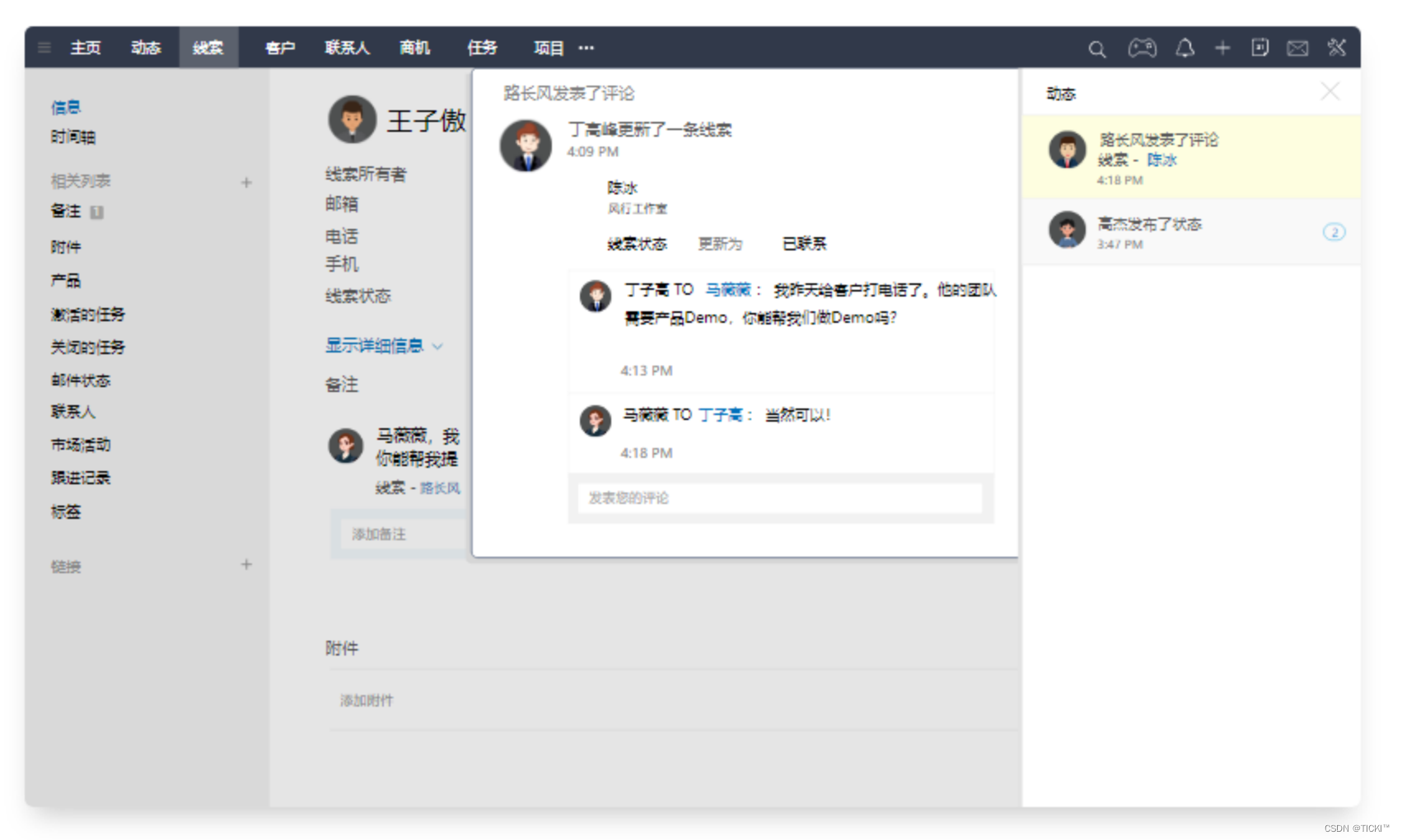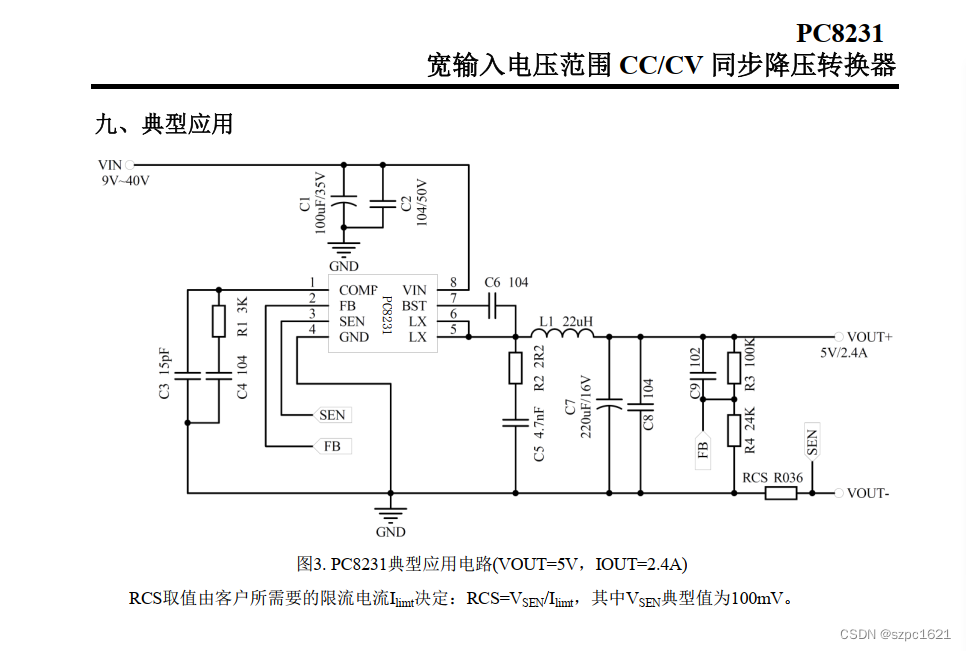代码地址、模型地址、安装环境:Ubuntu20.04,RTX3060 12G
一、部署
1.1 下载代码
cd /opt
git clone https://github.com/THUDM/ChatGLM2-6B
1.2 下载模型
将模型下载后放到项目文件夹内
git lfs install # 确认安装了lfs,或者直接到项目地址点击下载
git clone https://huggingface.co/THUDM/chatglm2-6b
1.3 拉取依赖
pip3 install -r requirements.txt -i https://pypi.tuna.tsinghua.edu.cn/simple
pip3 install tensorboard gradio mdtex2html -i https://pypi.tuna.tsinghua.edu.cn/simple
1.4 NVIDIA显卡驱动安装
找不到驱动
nvidia-smi # 输入指令>>>
NVIDIA-SMI has failed because it couldn't communicate with the NVIDIA driver. Make sure that the latest NVIDIA driver is installed and running.
查看内核版本
uname -r
下载新的内核
sudo apt-get install linux-generic-hwe-20.04 #这个是下载新的内核版本
删掉旧NVIDIA驱动
$ sudo apt-get purge libnvidia*
$ sudo apt-get purge nvidia*
下载驱动
$ sudo dpkg --list | grep nvidia #找版本
$ ubuntu-drivers devices #这样也行。
安装驱动
$ sudo add-apt-repository ppa:graphics-drivers/ppa
$ sudo apt-get update
$ sudo apt-get install nvidia-driver-535
$ sudo prime-select nvidia
# ------------- 如果上面有报错的话 -----------------------
$ sudo apt-get install --reinstall nvidia-driver-535
# -------------------------------------------------------
$ reboot # 重启
查看驱动
$ nvidia-smi
1.5 修改测试文件
1.5.1 修改模型地址
将web_demo.py中的"THUDM/chatglm2-6b"模型地址指向保存的模型地址"/opt/ChatGlm6B2/model"
1.5.2 按性能选择模型载入
# 全精度全加载
model = AutoModel.from_pretrained("/opt/ChatGlm6B2/model", trust_remote_code=True).cuda()
# 半精度全加载
model = AutoModel.from_pretrained("/opt/ChatGlm6B2/model", trust_remote_code=True).half().cuda()
# 半精度8bit量化
model = AutoModel.from_pretrained("/opt/ChatGlm6B2/model", trust_remote_code=True).quantize(8).half().cuda()
# 半精度4bit量化
model = AutoModel.from_pretrained("/opt/ChatGlm6B2/model", trust_remote_code=True).quantize(4).half().cuda()
1.5.3 修改启动端口
# demo.queue().launch(share=False, inbrowser=True)
demo.queue().launch(share=True, inbrowser=True, server_name='127.0.0.1', server_port=8080)
1.5.4 gradio无法构建可访问链接
下载文件:
wget https://cdn-media.huggingface.co/frpc-gradio-0.2/frpc_linux_amd64
重命名下载的文件:
mv frpc_linux_amd64 frpc_linux_amd64_v0.2
将文件移动到指定位置:
mv frpc_linux_amd64_v0.2 /root/.virtualenvs/glm/lib/python3.8/site-packages/gradio
找到文件
cd /root/.virtualenvs/glm/lib/python3.8/site-packages/gradio
授予权限
chmod 777 frpc_linux_amd64_v0.2
1.6 测试运行
# Gradio 启动
workon glm
cd /opt/ChatGlm6B2
python3 web_demo.py
# --------------------------------------------------------------------
python3 /opt/ChatGlm6B2/web_demo.py
# 或者 Streamlit 启动
workon glm
cd /opt/ChatGlm6B2
streamlit run web_demo2.py --server.port 8080
# --------------------------------------------------------------------
streamlit run /opt/ChatGlm6B2/web_demo2.py --server.port 8080
二、P-Tuning v2 微调
2.1 安装依赖
# 除了部署需要的依赖之外,还需要安装以下依赖
pip install rouge_chinese nltk jieba datasets transformers[torch] -i https://pypi.douban.com/simple/
2.2 下载数据集
2.2.1 编写数据
参考 answers.xlsx 、 dev.xlsx 编写自己的数据
2.2.2 生成json数据
使用 GetPrompts.py、或者使用打包好的 GetPrompts.exe 将数据转化为json,其中history默认按,分隔
2.2.3 移入文件夹
将整理好的数据集移入文件夹,参考执行脚本中即将配置的路径../answers.json和../dev.json,将文件放到以下位置
/opt/ChatGlm6B2/answers.json
/opt/ChatGlm6B2/dev.json
完整文件结构
/opt/ChatGlm6B2
/model
/output
answers.json
dev.json
/ptuning
main.py
train_chat.sh
…
…
2.3 修改微调脚本
# /opt/ChatGlm6B2/ptuning/train_chat.sh
# torchrun命令运行PyTorch训练脚本:
# torchrun: 运行PyTorch --standalone以独立模式运行(即在单个节点上运行,而不是在分布式环境中运行) --nnodes=1 指定节点的数量为1(即单节点运行) --nproc-per-node=$NUM_GPUS 指定每个节点上的进程数(GPU的数量) main.py 运行的PyTorch训练脚本
# do_train: 指定进行训练。
# train_file $CHAT_TRAIN_DATA: 指定训练数据文件的路径。
# validation_file $CHAT_VAL_DATA: 指定验证数据文件的路径。
# preprocessing_num_workers 10: 指定预处理数据时使用的工作进程数。
# prompt_column prompt: 指定数据中包含提示的列名。
# response_column response: 指定数据中包含响应的列名。
# history_column history: 指定数据中包含历史对话的列名。
# overwrite_cache: 指定是否覆盖缓存的预处理数据。
# model_name_or_path THUDM/chatglm2-6b: 指定模型的名称或路径,这里使用了一个预训练的聊天生成模型。
# output_dir $CHECKPOINT_NAME: 指定输出目录的路径。
# overwrite_output_dir: 指定是否覆盖输出目录。
# max_source_length 256: 指定输入序列的最大长度。
# max_target_length 256: 指定目标序列的最大长度。
# per_device_train_batch_size 1: 指定每个设备的训练批次大小。
# per_device_eval_batch_size 1: 指定每个设备的评估批次大小。
# gradient_accumulation_steps 16: 指定梯度累积的步数。
# predict_with_generate: 指定在生成模式下进行预测。
# max_steps 3000: 指定训练的最大步数。
# logging_steps 10: 指定每隔多少步打印一次日志。
# save_steps 1000: 指定每隔多少步保存一次模型。
# learning_rate $LR: 指定学习率,其中`$LR`是一个环境变量,用于指定学习率的值。
# pre_seq_len $PRE_SEQ_LEN: 指定预处理序列的长度,用于指定预处理序列的长度。
# quantization_bit 4: 指定量化的位数。
PRE_SEQ_LEN=128
LR=1e-2
NUM_GPUS=1
# 对话数据
CHAT_TRAIN_DATA=../answers.json
# 验证数据
CHAT_VAL_DATA=../dev.json
# 保存路径
CHECKPOINT_NAME=../output
# 模型路径
MODEL_PATH=../model
# 训练最大步数 3000默认
MAX_STEP=500
# 一个巨坑:为了加快速度,减小了MAX_STEP,但是保存步长还是1000,未达到保存条件没保存模型文件,重头来过
# 保存步长
SAVE_STEP=100
torchrun --standalone --nnodes=1 --nproc-per-node=$NUM_GPUS main.py \
--do_train \
--train_file $CHAT_TRAIN_DATA \
--validation_file $CHAT_VAL_DATA \
--preprocessing_num_workers 10 \
--prompt_column prompt \
--response_column response \
--history_column history \
--overwrite_cache \
--model_name_or_path $MODEL_PATH \
--output_dir $CHECKPOINT_NAME/chatglm-6b-pt-$PRE_SEQ_LEN-$LR \
--overwrite_output_dir \
--max_source_length 512 \
--max_target_length 512 \
--per_device_train_batch_size 1 \
--per_device_eval_batch_size 1 \
--gradient_accumulation_steps 16 \
--predict_with_generate \
--max_steps $MAX_STEP \
--logging_steps 10 \
--save_steps $SAVE_STEP \
--learning_rate $LR \
--pre_seq_len $PRE_SEQ_LEN \
--quantization_bit 4
2.4 执行微调脚本
workon glm
cd /opt/ChatGlm6B2/ptuning
sh train_chat.sh # bash train_chat.sh
---------------------------------------------------------------
nohup sh train_chat.sh > output.log # 后台执行 | 不生效

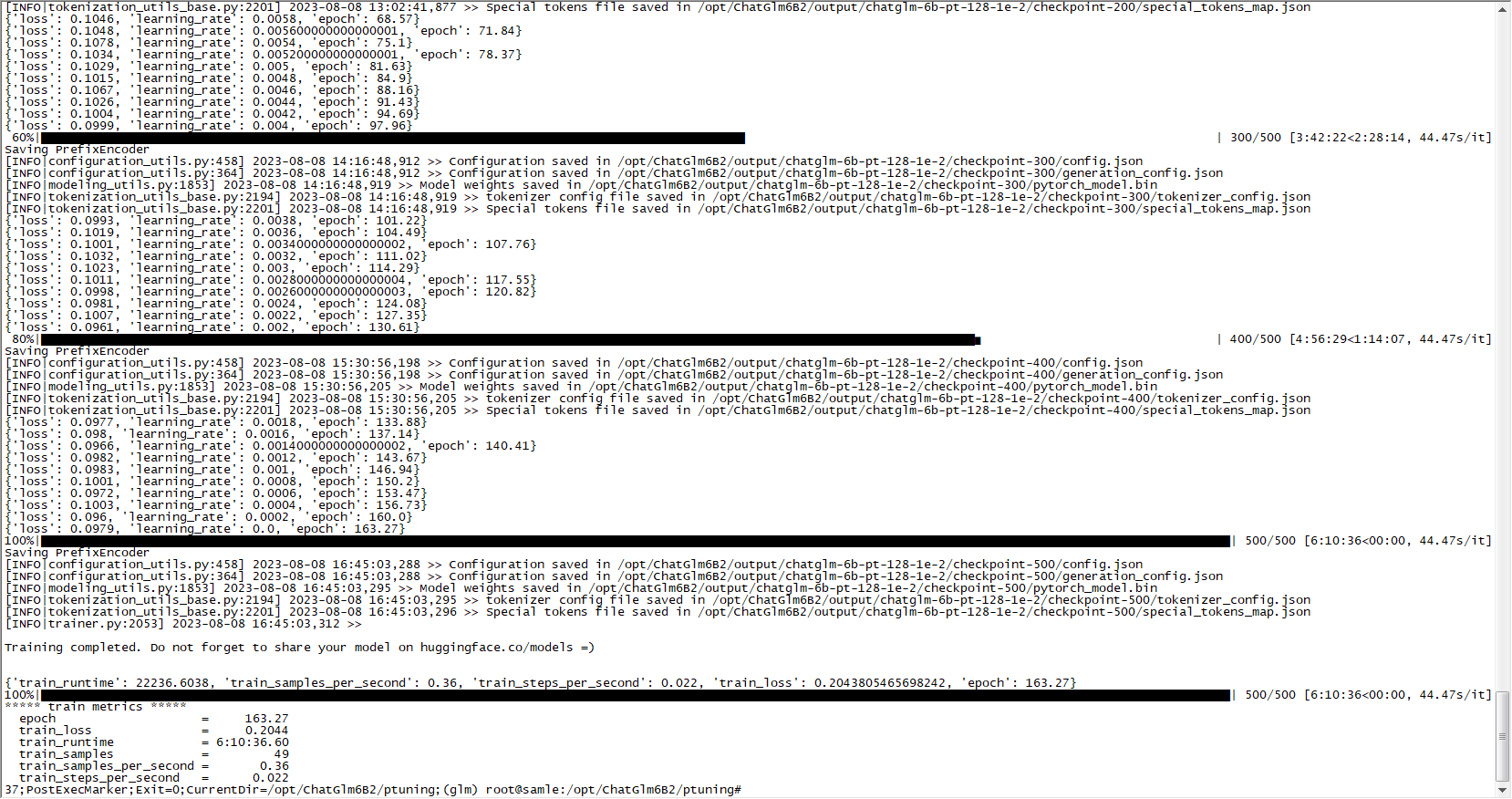
2.5 修改评估脚本
评估模型质量,可跳过
# /opt/ChatGlm6B2/ptuning/evaluate.sh
# model_name_or_path:原始ChatGLM-6B模型文件路径
# ptuning_checkpoint:训练完成后,生成的文件目录
LR=1e-2
PRE_SEQ_LEN=128
NUM_GPUS=1
# 验证数据
CHAT_VAL_DATA=../dev.json
# 保存路径
CHECKPOINT_NAME=../output
# 模型路径
MODEL_PATH=../model
# 最大步数
MAX_STEP=500
torchrun --standalone --nnodes=1 --nproc-per-node=$NUM_GPUS main.py \
--do_predict \
--validation_file $CHAT_VAL_DATA \
--test_file $CHAT_VAL_DATA \
--overwrite_cache \
--prompt_column prompt \
--response_column response \
--history_column history \
--model_name_or_path $MODEL_PATH \
--ptuning_checkpoint $CHECKPOINT_NAME/chatglm-6b-pt-$PRE_SEQ_LEN-$LR/checkpoint-$MAX_STEP \
--output_dir $CHECKPOINT_NAME/chatglm-6b-pt-$PRE_SEQ_LEN-$LR \
--overwrite_output_dir \
--max_source_length 64 \
--max_target_length 64 \
--per_device_eval_batch_size 1 \
--predict_with_generate \
--pre_seq_len $PRE_SEQ_LEN \
--quantization_bit 4
2.6 执行评估脚本
workon glm
cd /opt/ChatGlm6B2/ptuning
sh evaluate.sh # bash evaluate.sh
2.7 测试模型效果
修改web_demo.py或web_demo2.py中的模型引入
原模型引入
tokenizer = AutoTokenizer.from_pretrained("/opt/ChatGlm6B2/model", trust_remote_code=True) # 载入Tokenizer
model = AutoModel.from_pretrained("/opt/ChatGlm6B2/model", trust_remote_code=True).quantize(8).cuda() # 全精度8bit量化
# model = AutoModel.from_pretrained("/opt/ChatGlm6B2/model", trust_remote_code=True).cuda() # 全精度全加载
# model = AutoModel.from_pretrained("/opt/ChatGlm6B2/model", trust_remote_code=True).half().cuda() # 半精度全加载
# model = AutoModel.from_pretrained("/opt/ChatGlm6B2/model", trust_remote_code=True).quantize(8).half().cuda() # 半精度8bit量化
# model = AutoModel.from_pretrained("/opt/ChatGlm6B2/model", trust_remote_code=True).quantize(4).half().cuda() # 半精度4bit量化
## 多显卡支持,使用下面两行代替上面一行,将num_gpus改为你实际的显卡数量
## from utils import load_model_on_gpus
## model = load_model_on_gpus("/opt/ChatGlm6B2/model", num_gpus=2)
model = model.eval()
修改后模型引入
tokenizer = AutoTokenizer.from_pretrained("/opt/ChatGlm6B2/model", trust_remote_code=True) # 载入Tokenizer
# 加载的 P-Tuning 的 checkpoint:
# 注意: 将 pre_seq_len 改成训练时的实际值。
# /opt/ChatGlm6B2/model 指向本地的模型路径(注意不是checkpoint路径)
# /opt/ChatGlm6B2/output/chatglm-6b-pt-128-1e-2/checkpoint-500 指向生成的微调模型文件路径
config = AutoConfig.from_pretrained("/opt/ChatGlm6B2/model", trust_remote_code=True, pre_seq_len=128)
model = AutoModel.from_pretrained("/opt/ChatGlm6B2/model", config=config, trust_remote_code=True)
prefix_state_dict = torch.load(os.path.join("/opt/ChatGlm6B2/output/chatglm-6b-pt-128-1e-2/checkpoint-500", "pytorch_model.bin"))
new_prefix_state_dict = {}
for k, v in prefix_state_dict.items():
if k.startswith("transformer.prefix_encoder."):
new_prefix_state_dict[k[len("transformer.prefix_encoder."):]] = v
model.transformer.prefix_encoder.load_state_dict(new_prefix_state_dict)
## 如果需要加载的是全参数微调的 checkpoint,则直接加载整个 checkpoint:
## model = AutoModel.from_pretrained("/opt/ChatGlm6B2/output/chatglm-6b-pt-128-1e-2/checkpoint-500", trust_remote_code=True)
## 之后根据需求可以进行量化,也可以直接使用:
model = model.quantize(8)
model = model.cuda()
model = model.eval()
执行
workon glm
python3 /opt/ChatGlm6B2/web_demo.py # Gradio 启动
streamlit run /opt/ChatGlm6B2/web_demo2.py --server.port 8080 # 或者 Streamlit 启动

三、接口调用
3.1 接口脚本
from fastapi import FastAPI, Request
from transformers import AutoConfig, AutoModel, AutoTokenizer
import uvicorn, json, datetime
import torch
import os
DEVICE = "cuda"
DEVICE_ID = "0"
CUDA_DEVICE = f"{DEVICE}:{DEVICE_ID}" if DEVICE_ID else DEVICE
def torch_gc():
if torch.cuda.is_available():
with torch.cuda.device(CUDA_DEVICE):
torch.cuda.empty_cache()
torch.cuda.ipc_collect()
app = FastAPI()
@app.post("/")
async def create_item(request: Request):
global model, tokenizer
json_post_raw = await request.json()
json_post = json.dumps(json_post_raw)
json_post_list = json.loads(json_post)
prompt = json_post_list.get('prompt')
history = json_post_list.get('history')
max_length = json_post_list.get('max_length')
top_p = json_post_list.get('top_p')
temperature = json_post_list.get('temperature')
response, history = model.chat(tokenizer,
prompt,
history=history,
max_length=max_length if max_length else 2048,
top_p=top_p if top_p else 0.7,
temperature=temperature if temperature else 0.95)
now = datetime.datetime.now()
time = now.strftime("%Y-%m-%d %H:%M:%S")
answer = {
"response": response,
"history": history,
"status": 200,
"time": time
}
log = "[" + time + "] " + '", prompt:"' + prompt + '", response:"' + repr(response) + '"'
print(log)
torch_gc()
return answer
if __name__ == '__main__':
# ------------------------------------------------------------------------------------------------------------------------------------------
# 使用原模型参数
# tokenizer = AutoTokenizer.from_pretrained("/opt/ChatGlm6B2/model", trust_remote_code=True)
# # model = AutoModel.from_pretrained("/opt/ChatGlm6B2/model", trust_remote_code=True).cuda() # 全精度全加载
# model = AutoModel.from_pretrained("/opt/ChatGlm6B2/model", trust_remote_code=True).quantize(8).cuda() # 全精度全加载
# # model = AutoModel.from_pretrained("/opt/ChatGlm6B2/model", trust_remote_code=True).half().cuda() # 半精度全加载
# # model = AutoModel.from_pretrained("/opt/ChatGlm6B2/model", trust_remote_code=True).quantize(8).half().cuda() # 半精度8bit量化
# # model = AutoModel.from_pretrained("/opt/ChatGlm6B2/model", trust_remote_code=True).quantize(4).half().cuda() # 半精度4bit量化
# # 多显卡支持,使用下面两行代替上面一行,将num_gpus改为你实际的显卡数量
# # from utils import load_model_on_gpus
# # model = load_model_on_gpus("/opt/ChatGlm6B2/model", num_gpus=2)
# ------------------------------------------------------------------------------------------------------------------------------------------
# 使用微调后参数
tokenizer = AutoTokenizer.from_pretrained("/opt/ChatGlm6B2/model", trust_remote_code=True) # 载入Tokenizer
# 加载的 P-Tuning 的 checkpoint:
# 注意: 将 pre_seq_len 改成训练时的实际值。
# /opt/ChatGlm6B2/model 指向本地的模型路径(注意不是checkpoint路径)
# /opt/ChatGlm6B2/output/chatglm-6b-pt-128-1e-2/checkpoint-500 指向生成的微调模型文件路径
config = AutoConfig.from_pretrained("/opt/ChatGlm6B2/model", trust_remote_code=True, pre_seq_len=128)
model = AutoModel.from_pretrained("/opt/ChatGlm6B2/model", config=config, trust_remote_code=True)
prefix_state_dict = torch.load(os.path.join("/opt/ChatGlm6B2/output/chatglm-6b-pt-128-1e-2/checkpoint-500", "pytorch_model.bin"))
new_prefix_state_dict = {}
for k, v in prefix_state_dict.items():
if k.startswith("transformer.prefix_encoder."):
new_prefix_state_dict[k[len("transformer.prefix_encoder."):]] = v
model.transformer.prefix_encoder.load_state_dict(new_prefix_state_dict)
## 如果需要加载的是全参数微调的 checkpoint,则直接加载整个 checkpoint:
## model = AutoModel.from_pretrained("/opt/ChatGlm6B2/output/chatglm-6b-pt-128-1e-2/checkpoint-500", trust_remote_code=True)
# 之后根据需求可以进行量化,也可以直接使用:
model = model.quantize(8)
model = model.cuda()
# ------------------------------------------------------------------------------------------------------------------------------------------
model.eval()
uvicorn.run(app, host='0.0.0.0', port=8080, workers=1)
3.2 执行脚本
workon glm
python /opt/ChatGlm6B2/web_demo.py
# 挂载后台执行
nohup /root/.virtualenvs/glm/bin/python /opt/ChatGlm6B2/api.py > /opt/ChatGlm6B2/output.log 2>&1 &
nohup /root/.virtualenvs/glm/bin/python /opt/ChatGlm6B2/openai_api.py > /opt/ChatGlm6B2/apilog.log 2>&1 &
# 终止
ps aux | grep api.py
kill PID
3.3 调用接口
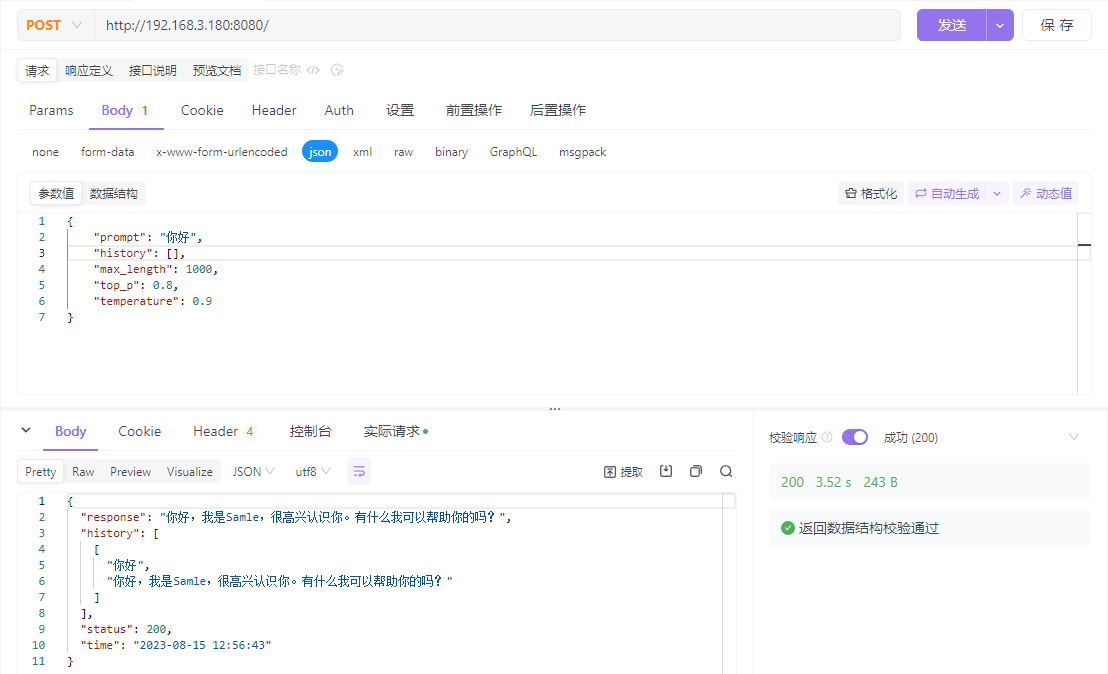
3.4 Vue调用
代理转发
const path = require('path')
const { defineConfig } = require('@vue/cli-service')
module.exports = defineConfig({
devServer: {
proxy: {
'/chatglm': { // 部署前 取消注释
target: 'http://127.0.0.1:8080/', // API服务器的地址
// ws: true, // 如果要代理 websockets,配置这个参数
changeOrigin: true, // 是否跨域
pathRewrite: {
'^/chatglm': ''
}
},
}
}
})
部署后使用Nginx代理
# vi /etc/nginx/nginx.conf
server {
listen 8080; # 前端项目开放监听端口
server_name 127.0.0.1; # 前端项目开放ip/域名
location / { # 默认根路径
root /var/www/chat/; # build文件的位置
try_files $uri $uri/ /index.html; # 内部文件重定向
}
location / chatglm { # 默认根路径
proxy_redirect off;
proxy_set_header Host $host;
proxy_set_header X-Real-IP $remote_addr;
proxy_set_header X-Forwarded-For $proxy_add_x_forwarded_for;
proxy_http_version 1.1;
proxy_set_header Upgrade $http_upgrade;
proxy_set_header Connection "upgrade";
proxy_connect_timeout 1800s;
proxy_send_timeout 1800s;
proxy_read_timeout 1800s;
proxy_pass http://127.0.0.1:8080/;
}
}
封装函数
import axios from 'axios'
import { message } from 'element-ui'
export async function postChat(prompt, history=[], max_length=1000, top_p=0.8, temperature=0.9) {
const { data: res } = await axios.post( '/chatglm',
{
"prompt": prompt,
"history": history,
"max_length": max_length,
"top_p": top_p,
"temperature": temperature
}
)
console.log(res)
if (res.status !== 200) {
return message.error('接口异常,请重新尝试或联系管理员!')
}
}
调用函数
<script>
import { postChat } from '@/api/ChatApi.js'
export default {
data() {
return {}
},
created(){
postChat("你好")
},
}
</script>
